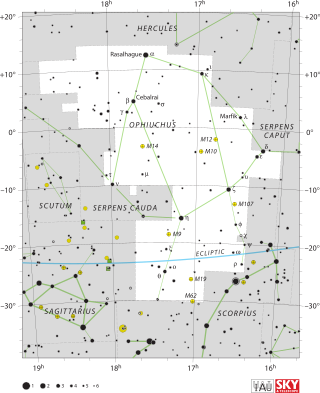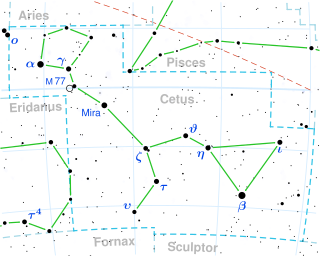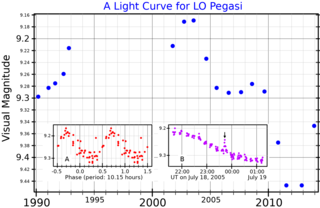
Zeta Reticuli, Latinized from ζ Reticuli, is a wide binary star system in the southern constellation of Reticulum. From the southern hemisphere the pair can be seen with the naked eye as a double star in very dark skies. Based upon parallax measurements, this system is located at a distance of about 39.3 light-years from Earth. Both stars are solar analogs that have characteristics similar to those of the Sun. They belong to the Zeta Herculis Moving Group of stars that share a common origin.
70 Ophiuchi is a binary star system located 16.6 light years away from the Earth. It is in the constellation Ophiuchus. At magnitude 4 it appears as a dim star visible to the unaided eye away from city lights.

36 Ophiuchi is a triple star system 19.5 light-years from Earth. It is in the constellation Ophiuchus.

Beta Ophiuchi or β Ophiuchi, also named Cebalrai, is a star in the equatorial constellation of Ophiuchus. The apparent visual magnitude of this star is 2.7, which is readily visible to the naked eye even from urban skies. The distance to this star can be estimated using parallax measurements, yielding a value of 81.8 light-years from the Sun.
HD 89744 is a star in the northern circumpolar constellation of Ursa Major, positioned about 0.4° due south of the bright star Tania Australis. This object has a yellow-white hue and is dimly visible to the naked eye with an apparent visual magnitude of 5.73. The distance to this star has been measured using the patallax method, which locates it 126 light years from the Sun. It is drifting closer with a radial velocity of −4.4 km/s. There are two known exoplanets orbiting this star.

Kappa1 Ceti, Latinized from κ1 Ceti, is a variable yellow dwarf star approximately 30 light-years away in the equatorial constellation of Cetus.
61 Ursae Majoris, abbreviated 61 UMa, is a single star in the northern circumpolar constellation of Ursa Major. It has a yellow-orange hue and is dimly visible to the naked eye with an apparent visual magnitude of 5.35. The distance to this star is 31.2 light years based on parallax, and it is drifting closer with a radial velocity of −5.2 km/s. The star has a relatively high proper motion traversing the sky at the rate of 0.381″ yr−1.

58 Eridani is a main-sequence star in the constellation Eridanus. It is a solar analogue, having similar physical properties to the Sun. The star has a relatively high proper motion across the sky, and it is located 43 light years distant. It is a probable member of the IC 2391 moving group of stars that share a common motion through space.
HD 222582 is a multiple star system in the equatorial constellation of Aquarius. It is invisible to the naked eye with an apparent visual magnitude of 7.7, but can be viewed with binoculars or a small telescope. The system is located at a distance of 138 light years from the Sun based on parallax, and it is drifting further away with a radial velocity of +12 km/s. It is located close enough to the ecliptic that it is subject to lunar occultations.
51 Ophiuchi is a single star located approximately 410 light years away from the Sun in the equatorial constellation of Ophiuchus, northwest of the center of the Milky Way. It is visible to the naked eye as a faint, blue-white point of light with an apparent visual magnitude of 4.81. The star is moving closer to the Earth with a heliocentric radial velocity of –12 km/s.

Pi Herculis is a third-magnitude star in the constellation Hercules. As one of the four stars in the Keystone asterism, it is one of the constellation's more easily recognized. It has an apparent visual magnitude of +3.2, which is visible to the naked eye and makes it one of its brighter members. The Hipparcos satellite mission estimated its distance at roughly 115 parsecs from Earth, or about 377 light years away. The overall reduction in the star's visual magnitude due to extinction from the intervening matter is 0.11.

Chi Ophiuchi, Latinized from χ Ophiuchi, is a variable star in the equatorial constellation of Ophiuchus. It has a blue-white hue and is faintly visible to the naked eye with an apparent visual magnitude that fluctuates around 4.22. The distance to this object, as determined from parallax measurements, is approximately 500 light years, but it is moving closer to the Sun with a radial velocity of −19 km/s. This star is a proper motion member of the Upper Scorpius sub-group in the Scorpius–Centaurus OB association; the nearest such co-moving association of massive stars to the Sun.

111 Tauri is a wide binary star system in the constellation Taurus. It is located at a distance of 48 light years from the Sun. Primary component A is a main sequence star with a stellar classification of F8V. The secondary component B is a K-type main sequence star. The primary is larger and more luminous than the Sun, with about 130% of the Sun's radius and 185% of the Sun's luminosity. The apparent magnitude of 5.0 indicates it is a faint star that can be viewed by the naked eye under good, dark-sky conditions.
Tau1 Hydrae is a triple star system in the equatorial constellation of Hydra. Based upon the annual parallax shift of the two visible components as seen from Earth, they are located about 18 parsecs (59 ly) from the Sun. The system has a combined apparent visual magnitude of +4.59, which is bright enough to be visible to the naked eye at night.
σ Pegasi, Latinised as Sigma Pegasi, is a binary star system in the northern constellation of Pegasus. With a combined apparent visual magnitude of 5.16, it is faintly visible to the naked eye. Based upon an annual parallax shift of 36.66 mas as seen from Earth, the system is located 89 light years distant from the Sun. It has a relatively high proper motion, advancing across the celestial sphere at the rate of 0.524 arcseconds per year.

Gliese 402 is a star located 22.7 light years from the Solar System. Located in the constellation of Leo, it is also known as Wolf 358 from its entry in Max Wolf's star catalogue. The stars nearest to Gliese 402 are Gliese 393, at 3.43 light years, Gliese 408, at 6.26 light years, and Gliese 382 at 6.66 light years.

HN Pegasi is the variable star designation for a young, Sun-like star in the northern constellation of Pegasus. It has an apparent visual magnitude of 5.9, which, according to the Bortle scale, indicates that it is visible to the naked eye from suburban skies. Parallax measurements put the star at a distance of around 59 light years from the Sun, but it is drifting closer with a radial velocity of −16.7 km/s.

V1794 Cygni is a single variable star in the northern constellation Cygnus. It has the identifier HD 199178 from the Henry Draper Catalogue; V1794 Cygni is its variable star designation. With an apparent visual magnitude of 7.24, it's too dim to be visible with the naked eye but can be seen with binoculars. V1794 is located at a distance of 367 light-years (113 pc) based on parallax measurements, but is drifting closer to the Sun with a radial velocity of −31 km/s. It lies superimposed over a region of faint nebulosity to the west of the North American Nebula.

LO Pegasi is a single star in the northern constellation of Pegasus that has been the subject of numerous scientific studies. LO Pegasi, abbreviated LO Peg, is the variable star designation. It is too faint to be viewed with the naked eye, having an apparent visual magnitude that ranges from 9.04 down to 9.27. Based on parallax measurements, LO Peg is located at a distance of 79 light years from the Sun. It is a member of the young AB Doradus moving group, and is drifting closer with a radial velocity of −23 km/s.

HR 1099 is a triple star system in the equatorial constellation of Taurus, positioned 11′ to the north of the star 10 Tauri. This system has the variable star designation V711 Tauri, while HR 1099 is the star's identifier from the Bright Star Catalogue. It ranges in brightness from a combined apparent visual magnitude of 5.71 down to 5.94, which is bright enough to be dimly visible to the naked eye. The distance to this system is 96.6 light years based on parallax measurements, but it is drifting closer with a radial velocity of about −15 km/s.













